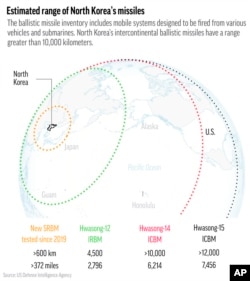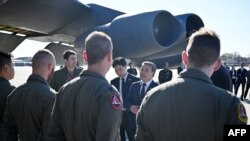U.S. and South Korean warplanes will continue large-scale joint military exercises for another day, officials announced Friday, as North Korea continued lashing out at the drills with a record pace of launches.
The Vigilant Storm air drill, which involves 240 aircraft running mock attacks, will now run through Saturday, South Korea’s military announced, citing North Korean provocations.
Since Wednesday, North Korea has launched 30 missiles, including some that triggered air raid alerts and emergency shelter orders in South Korea and Japan.
The United Nations Security Council will meet Friday to discuss North Korea’s launches, at the request of countries including the United States, multiple diplomats told VOA.
Overnight, North Korea also launched 80 artillery rounds into a sensitive sea border area off its east coast, according to a statement by South Korea’s Joint Chiefs of Staff.
In Washington, the South Korean and U.S. defense chiefs vowed Thursday to increase their defense posture in response to North Korea’s tests.
South Korean National Defense Minister Lee Jong-sup, speaking alongside his U.S. counterpart, Defense Secretary Lloyd Austin, said the U.S. agreed to deploy strategic assets “to the level equivalent to constant deployment.”
South Korea has urged the United States to send more nuclear-capable warplanes and ships to the region, as North Korean leader Kim Jong Un ramps up missile tests and warns of his ability to conduct tactical nuclear strikes against the South.
“Any nuclear attack against the United States or its Allies and partners, including the use of non-strategic nuclear weapons, is unacceptable and will result in the end of the Kim regime,” Austin said, according to a joint statement issued after the meeting at the Pentagon.
The two leaders also visited a U.S. air base just outside Washington, where they posed with B-1B and B-52 bombers, the latter of which is nuclear-capable. During past cycles of tension, the U.S. has run those bombers across the Korean Peninsula in a show of force.
North Korea strongly objects to such displays. It also uses them as an occasion to show off its own weapons.
In a late-night statement slamming the extension of the U.S.-South Korean drills, a senior North Korean official blamed Washington and Seoul for bringing tensions to an “uncontrollable phase.”
“The U.S. and south Korea will get to know what an irrevocable and awful mistake they made,” said the statement by Pak Jong Chon, a senior official in North Korea’s ruling Workers’ Party.
North Korea has fired about 60 ballistic missiles this year, a record, by far. Its launches this week have been among its most provocative yet.
The launches created especially tense situations in northern Japan early Thursday. In Miyagi, Yamagata, and Niigata prefectures residents were warned to take shelter indoors.
Japanese television broadcasts were also interrupted by emergency alerts, which initially said a North Korean missile flew over and past Japanese territory. However, defense officials later retracted that claim, saying they lost track of the missile while it was flying over the sea.
North Korea aimed three of Wednesday’s launches toward South Korea, triggering television alerts in the South and air raid sirens on an island off the coast.
In response, South Korea’s military on Wednesday said its warplanes launched three missiles north of the de facto sea border to demonstrate South Korea’s “capability and readiness to strike the enemy with precision.”
Neither country had sent missiles across the Northern Limit Line since the end of the 1950-53 Korean War; on Wednesday they both did within hours of each other.


